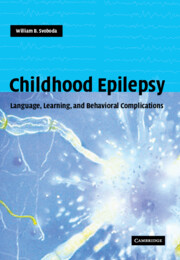Book contents
- Frontmatter
- Contents
- Preface
- Glossary
- 1 Looking ahead
- Part I Speech and language problems
- Part II Learning problems
- 12 Learning challenges
- 13 The development of learning
- 14 Learning difficulties
- 15 Learning problems with seizure types
- 16 Modifying factors
- 17 Transient cognitive impairments of epilepsy
- 18 Attention and alertness
- 19 Memory
- 20 Executive functioning
- 21 Academics
- 22 Antiepileptic medication effects
- 23 Effects of other therapies
- 24 Diagnosis
- 25 Gaining help
- 26 Frustrations of learning problems
- Part III Behavior problems
- Index
- References
15 - Learning problems with seizure types
from Part II - Learning problems
Published online by Cambridge University Press: 26 October 2009
- Frontmatter
- Contents
- Preface
- Glossary
- 1 Looking ahead
- Part I Speech and language problems
- Part II Learning problems
- 12 Learning challenges
- 13 The development of learning
- 14 Learning difficulties
- 15 Learning problems with seizure types
- 16 Modifying factors
- 17 Transient cognitive impairments of epilepsy
- 18 Attention and alertness
- 19 Memory
- 20 Executive functioning
- 21 Academics
- 22 Antiepileptic medication effects
- 23 Effects of other therapies
- 24 Diagnosis
- 25 Gaining help
- 26 Frustrations of learning problems
- Part III Behavior problems
- Index
- References
Summary
Seizures may excite, distort, inhibit, or alter cognitive efforts when they are prolonged, are continuous, occur in a series, or even when they occur singly (Meador, 2002). Discharges may disrupt processing, thus interfering with attention, learning processing, or storage or retrieval of information. Discharges may disrupt consolidation processes of encoding, storage, and retrieval. Seizures are more deleterious to cognition if they are due to underlying brain damage. Brain damage may reduce the capability of the brain to react adaptively. The developing brain may compensate through plasticity. Damage to the mature brain may result in cognitive loss. Anticonvulsants may change neural functioning, affecting learning processes. Frequent sleep discharges may directly or indirectly disrupt brain functioning and, in the young child, brain development (Aldenkamp et al., 1990; Binnie et al., 1990; Blennow et al., 1990; Dam, 1990). Resultant cognitive impairments may be minimal to severe and progressive, depending on the seizure type, cause, and epileptic syndrome (Dam, 1990).
Epilepsy, of any type and at any age, may exist in benign and not so benign forms. Simple absence seizures are far less impairing than minor motor or atypical absence syndromes, especially in early syndromes (Farwell et al., 1984). Children with generalized seizures may have problems with intelligence and attention (Rennick et al., 1969; Wilkus & Dodrill, 1976), whereas children with partial seizures may have problems with learning disabilities, including perception and memory (Fedio & Mirsky, 1969; Stores, 1971).
- Type
- Chapter
- Information
- Childhood EpilepsyLanguage, Learning and Behavioural Complications, pp. 203 - 234Publisher: Cambridge University PressPrint publication year: 2004



